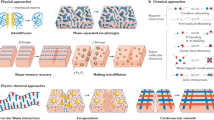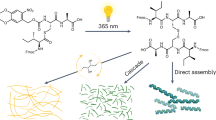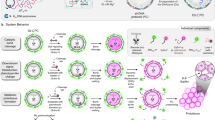Abstract
Biochemical networks interconnect, grow and evolve to express new properties as different chemical pathways are selected during a continuous cycle of energy consumption and transformation. In contrast, synthetic systems that push away from equilibrium usually return to the same self-assembled state, often generating waste that limits system recyclability and prevents the formation of adaptable networks. Here we show that annealing by slow proton dissipation selects for otherwise inaccessible morphologies of fibres built from DNA and cyanuric acid. Using single-molecule fluorescence microscopy, we observe that proton dissipation influences the growth mechanism of supramolecular polymerization, healing gaps within fibres and converting highly branched, interwoven networks into nanocable superstructures. Just as the growth kinetics of natural fibres determine their structural attributes to modulate function, our system of photoacid-enabled depolymerization and repolymerization selects for healed materials to yield organized, robust fibres. Our method provides a chemical route for error-checking, distinct from thermal annealing, that improves the morphologies and properties of supramolecular materials using out-of-equilibrium systems.

This is a preview of subscription content, access via your institution
Access options
Access Nature and 54 other Nature Portfolio journals
Get Nature+, our best-value online-access subscription
$29.99 / 30 days
cancel any time
Subscribe to this journal
Receive 12 print issues and online access
$259.00 per year
only $21.58 per issue
Buy this article
- Purchase on Springer Link
- Instant access to full article PDF
Prices may be subject to local taxes which are calculated during checkout





Similar content being viewed by others
Data availability
All data supporting the findings of this study are available in the main text or the supplementary materials.
References
Seeman, N. C. & Sleiman, H. F. DNA nanotechnology. Nat. Rev. Mater. 3, 17068 (2017).
Veneziano, R. et al. Role of nanoscale antigen organization on B-cell activation probed using DNA origami. Nat. Nanotechnol. 15, 716–723 (2020).
van Rossum, S. A. P., Tena-Solsona, M., van Esch, J. H., Eelkema, R. & Boekhoven, J. Dissipative out-of-equilibrium assembly of man-made supramolecular materials. Chem. Soc. Rev. 46, 5519–5535 (2017).
Arango-Restrepo, A., Barragán, D. & Rubi, J. M. Self-assembling outside equilibrium: emergence of structures mediated by dissipation. Phys. Chem. Chem. Phys. 21, 17475–17493 (2019).
Mattia, E. & Otto, S. Supramolecular systems chemistry. Nat. Nanotechnol. 10, 111–119 (2015).
Mishra, A. et al. Biomimetic temporal self-assembly via fuel-driven controlled supramolecular polymerization. Nat. Commun. 9, 1295 (2018).
Deng, J. & Walther, A. ATP-powered molecular recognition to engineer transient multivalency and self-sorting 4D hierarchical systems. Nat. Commun. 11, 3658 (2020).
Rieß, B., Grötsch, R. K. & Boekhoven, J. The design of dissipative molecular assemblies driven by chemical reaction cycles. Chem 6, 552–578 (2020).
Green, L. N. et al. Autonomous dynamic control of DNA nanostructure self-assembly. Nat. Chem. 11, 510–520 (2019).
Heinen, L. & Walther, A. Programmable dynamic steady states in ATP-driven nonequilibrium DNA systems. Sci. Adv. 5, eaaw0590 (2019).
Del Grosso, E., Amodio, A., Ragazzon, G., Prins, L. J. & Ricci, F. Dissipative synthetic DNA-based receptors for the transient loading and release of molecular cargo. Angew. Chem. Int. Ed. 57, 10489–10493 (2018).
Thubagere, A. J. et al. A cargo-sorting DNA robot. Science 357, eaan6558 (2017).
Mathur, D. & Medintz, I. L. The growing development of DNA nanostructures for potential healthcare-related applications. Adv. Healthc. Mater. 8, 1801546 (2019).
Shi, J., Shi, Z., Dong, Y., Wu, F. & Liu, D. Responsive DNA-based supramolecular hydrogels. ACS Appl. Bio Mater. 3, 2827–2837 (2020).
Tanaka, K. et al. Self-assembled metal array in artificial DNA. Science 299, 1212–1213 (2003).
Kondo, J. et al. A metallo-DNA nanowire with uninterrupted one-dimensional silver array. Nat. Chem. 9, 956–960 (2017).
Li, Q. et al. A poly(thymine)–melamine duplex for the assembly of DNA nanomaterials. Nat. Mater. 19, 1012–1018 (2020).
Hoshika, S. et al. DNA and RNA: a genetic system with eight building blocks. Science 363, 884–887 (2019).
Joesaar, A. et al. DNA-based communication in populations of synthetic protocells. Nat. Nanotechnol. 14, 369–378 (2019).
McLaughlin, C. K., Hamblin, G. D. & Sleiman, H. F. Supramolecular DNA assembly. Chem. Soc. Rev. 40, 5647–5656 (2011).
Platnich, C. M., Rizzuto, F. J., Cosa, G. & Sleiman, H. F. Single-molecule methods in structural DNA nanotechnology. Chem. Soc. Rev. 49, 4220–4233 (2020).
Rizzuto, F. J., Trinh, T. & Sleiman, H. F. Molecular printing with DNA nanotechnology. Chem 6, 1560–1574 (2020).
Merindol, R. & Walther, A. Materials learning from life: concepts for active, adaptive and autonomous molecular systems. Chem. Soc. Rev. 46, 5588–5619 (2017).
Zhang, F., Nangreave, J., Liu, Y. & Yan, H. Structural DNA nanotechnology: state of the art and future perspective. J. Am. Chem. Soc. 136, 11198–11211 (2014).
Grzybowski, B. A. & Huck, W. T. S. The nanotechnology of life-inspired systems. Nat. Nanotechnol. 11, 585–592 (2016).
Madsen, M. & Gothelf, K. V. Chemistries for DNA nanotechnology. Chem. Rev. 119, 6384–6458 (2019).
Colomer, I., Morrow, S. M. & Fletcher, S. P. A transient self-assembling self-replicator. Nat. Commun. 9, 2239 (2018).
Wood, C. S., Browne, C., Wood, D. M. & Nitschke, J. R. Fuel-controlled reassembly of metal–organic architectures. ACS Cent. Sci. 1, 504–509 (2015).
Jalani, K., Das, A. D., Sasmal, R., Agasti, S. S. & George, S. J. Transient dormant monomer states for supramolecular polymers with low dispersity. Nat. Commun. 11, 3967 (2020).
Singh, N., Lainer, B., Formon, G. J. M., De Piccoli, S. & Hermans, T. M. Re-programming hydrogel properties using a fuel-driven reaction cycle. J. Am. Chem. Soc. 142, 4083–4087 (2020).
Avakyan, N. et al. Reprogramming the assembly of unmodified DNA with a small molecule. Nat. Chem. 8, 368–376 (2016).
Alenaizan, A., Fauche, K., Krishnamurthy, R. & Sherrill, C. D. Noncovalent helicene structure between nucleic acids and cyanuric acid. Chem. Eur. J. 27, 4043–4052 (2021).
Markvoort, A. J., Eikelder, H. M. Mt, Hilbers, P. A. J. & de Greef, T. F. A. Fragmentation and coagulation in supramolecular (co)polymerization kinetics. ACS Cent. Sci. 2, 232–241 (2016).
Kang, J. et al. A rational strategy for the realization of chain-growth supramolecular polymerization. Science 347, 646–651 (2015).
Rupar, P. A., Chabanne, L., Winnik, M. A. & Manners, I. Non-centrosymmetric cylindrical micelles by unidirectional growth. Science 337, 559–562 (2012).
Aida, T., Meijer, E. W. & Stupp, S. I. Functional supramolecular polymers. Science 335, 813–817 (2012).
Matern, J., Dorca, Y., Sánchez, L. & Fernández, G. Revising complex supramolecular polymerization under kinetic and thermodynamic control. Angew. Chem. Int. Ed. 58, 16730–16740 (2019).
Chakraborty, S., Sharma, S., Maiti, P. K. & Krishnan, Y. The poly dA helix: a new structural motif for high performance DNA-based molecular switches. Nucleic Acids Res. 37, 2810–2817 (2009).
Shi, Z., Peng, P., Strohecker, D. & Liao, Y. Long-lived photoacid based upon a photochromic reaction. J. Am. Chem. Soc. 133, 14699–14703 (2011).
Kundu, P. K. et al. Light-controlled self-assembly of non-photoresponsive nanoparticles. Nat. Chem. 7, 646–652 (2015).
Zhao, D. & Moore, J. S. Nucleation–elongation: a mechanism for cooperative supramolecular polymerization. Org. Biomol. Chem. 1, 3471–3491 (2003).
Smulders, M. M. J. et al. How to distinguish isodesmic from cooperative supramolecular polymerisation. Chem. Eur. J. 16, 362–367 (2010).
Meisl, G. et al. Molecular mechanisms of protein aggregation from global fitting of kinetic models. Nat. Protoc. 11, 252–272 (2016).
Gidi, Y., Bayram, S., Ablenas, C. J., Blum, A. S. & Cosa, G. Efficient one-step PEG-silane passivation of glass surfaces for single-molecule fluorescence studies. ACS Appl. Mater. Interfaces 10, 39505–39511 (2018).
Castle, B. T., Odde, D. J. & Wood, D. K. Rapid and inefficient kinetics of sickle hemoglobin fibre growth. Sci. Adv. 5, eaau1086 (2019).
Weisel, J. W. & Nagaswami, C. Computer modeling of fibrin polymerization kinetics correlated with electron microscope and turbidity observations: clot structure and assembly are kinetically controlled. Biophys. J. 63, 111–128 (1992).
Jia, Z., Schmit, J. D. & Chen, J. Amyloid assembly is dominated by misregistered kinetic traps on an unbiased energy landscape. Proc. Natl Acad. Sci. USA 117, 10322–10328 (2020).
Zhu, S. et al. Self-assembly of collagen-based biomaterials: preparation, characterizations and biomedical applications. J. Mater. Chem. B 6, 2650–2676 (2018).
Acknowledgements
G.C. and H.F.S. are grateful to the National Science and Engineering Research Council of Canada (NSERC), the Canada Foundation for Innovation (CFI), and the Fonds de Recherche Nature et Technologies (FRQNT). H.F.S. is also grateful to the Canada Research Chairs Program, the Canada Council for the Arts for a Killam Fellowship, and is a Cottrell Scholar of the Research Corporation. A.G. thanks the Canada Institute for Health Research (CIHR) and the McGill Facility for Electron Microscopy Research (FEMR). F.J.R., C.M.P and C.L.-B. thank NSERC for a Banting Fellowship, CGS-D Scholarship, and Vanier Scholarship, respectively. The authors thank Y. Gidi for insightful discussions on the single-molecule data.
Author information
Authors and Affiliations
Contributions
F.J.R, C.M.P. and H.F.S. conceived and designed the experiments. F.J.R. and H.F.S. performed and analysed the ensemble experiments. C.M.P. and G.C. conceived, performed and analysed the single-molecule fluorescence experiments. X.L. and M.D.D. performed the AFM experiments. C.L.-B. performed the persistence length analyses. Y.S. and A.G. performed and analysed the cryo-EM experiments. F.J.R, C.M.P. and H.F.S. co-wrote the paper with input from all authors.
Corresponding author
Ethics declarations
Competing interests
The authors declare no competing interests.
Additional information
Peer review information Nature Chemistry thanks Subi George, Mathieu Surin and the other, anonymous, reviewer(s) for their contribution to the peer review of this work.
Publisher’s note Springer Nature remains neutral with regard to jurisdictional claims in published maps and institutional affiliations.
Supplementary information
Supplementary Information
Supplementary Figs. 1–44, methods and references.
Rights and permissions
About this article
Cite this article
Rizzuto, F.J., Platnich, C.M., Luo, X. et al. A dissipative pathway for the structural evolution of DNA fibres. Nat. Chem. 13, 843–849 (2021). https://doi.org/10.1038/s41557-021-00751-w
Received:
Accepted:
Published:
Issue Date:
DOI: https://doi.org/10.1038/s41557-021-00751-w
This article is cited by
-
Creating complex protocells and prototissues using simple DNA building blocks
Nature Communications (2023)
-
Dissipative DNA nanotechnology
Nature Chemistry (2022)
-
Cascaded dissipative DNAzyme-driven layered networks guide transient replication of coded-strands as gene models
Nature Communications (2022)
-
Dissipative DNA fibres
Nature Chemistry (2021)



